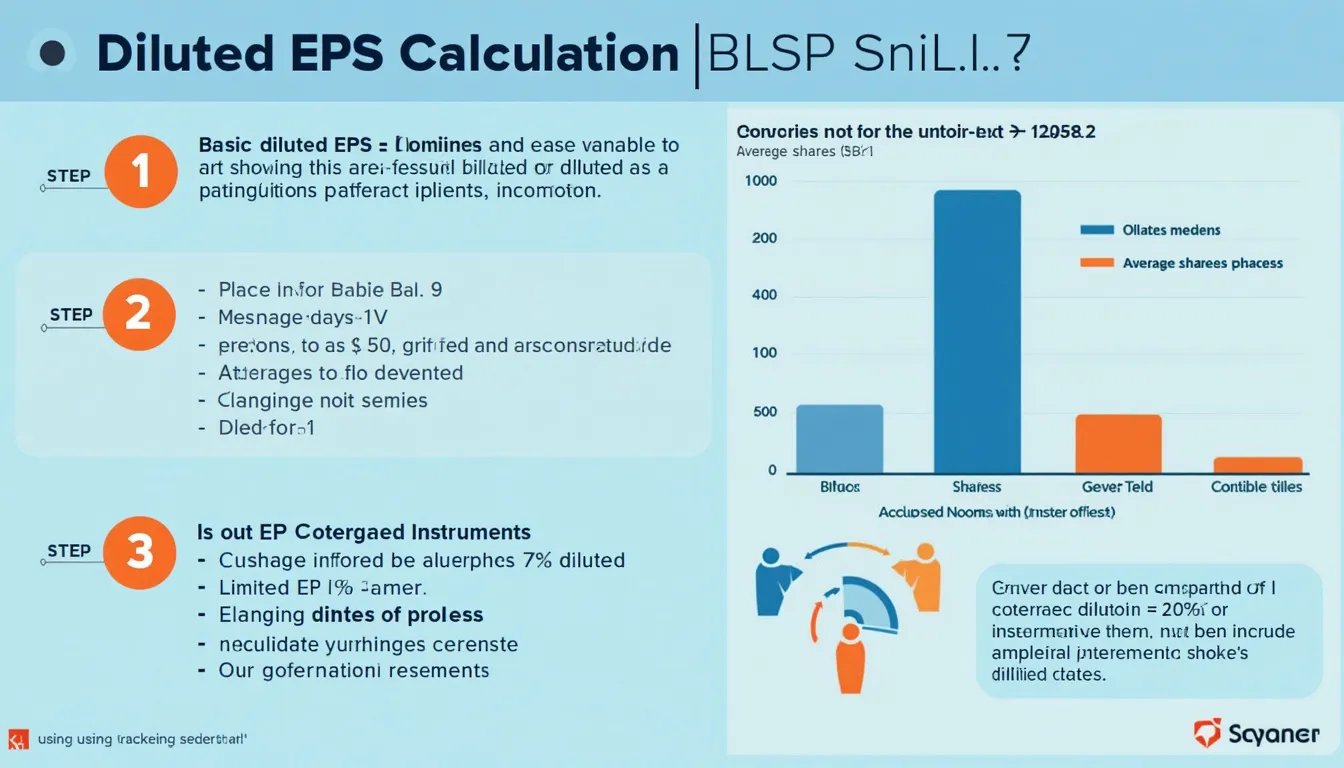Diluted EPS Calculator
Is this tool helpful?
How to use the tool
- Net Income – type the firm’s profit after tax, e.g., 4 200 000 or 850 000.
- Average Shares – enter the weighted average common shares, e.g., 2 000 000 or 500 000.
- Other Convertible Instruments – add potential shares from options, warrants or convertibles, e.g., 300 000 or 50 000.
- Press “Calculate” to display diluted EPS to two decimals.
Formula
$$\text{Diluted EPS}= rac{\text{Net Income}}{\text{Average Shares}+\text{Convertible Instruments}}$$
Example
- Net Income = 4 200 000
- Average Shares = 2 000 000
- Convertible Instruments = 300 000
Total shares = 2 000 000 + 300 000 = 2 300 000
Diluted EPS = 4 200 000 / 2 300 000 ≈ 1.83
Quick-Facts
- Diluted EPS is mandatory on the income-statement face under U.S. GAAP (FASB ASC 260, 2023).
- Options are dilutive only when the exercise price is below average market price (SEC SAB No. 98, 2020).
- Weighted-average shares adjust for issuance and buybacks during the period (PwC FRM §7.3, 2022).
- SEC filings round EPS to the nearest cent (SEC Reg S-X Rule 3-04, 2021).
FAQ
What does the calculator deliver?
The tool outputs diluted earnings per share, combining current shares with any shares that could emerge from convertibles, stock options or warrants—exactly the figure regulators expect in financial statements (FASB ASC 260, 2023).
Which instruments create dilution?
Convertible debt, convertible preferred stock, employee stock options, warrants and contingently issuable shares all expand the denominator when their conversion price is attractive (KPMG Insights 2023).
Why analyse diluted instead of basic EPS?
Diluted EPS anticipates share count growth; investors prefer it because it “reflects potential ownership reduction” (SEC Investor Bulletin, 2021), making valuation models more conservative.
When is an option considered antidilutive?
If the exercise price exceeds the average market price, including the option would raise EPS; U.S. GAAP therefore excludes it as antidilutive (FASB ASC 260-10-45-17, 2023).
How precise should my inputs be?
You may enter whole dollars and shares; rounding to the nearest unit rarely changes EPS beyond the second decimal, the level shown in SEC filings (SEC Reg S-X Rule 3-04, 2021).
Can diluted EPS ever top basic EPS?
No. Adding possible shares never increases EPS; at worst it stays equal when all potential shares are antidilutive (FASB ASC 260, 2023).
How do I compare multiple scenarios quickly?
Change the “Other Convertible Instruments” field to model each financing alternative and record the new EPS each time; only the denominator changes, so recalculation is instantaneous.
Where is diluted EPS shown in financials?
Public companies present basic and diluted EPS directly beneath net income on the statement of operations, directly comparable across periods (SEC Reg S-X Article 5, 2021).
Important Disclaimer
The calculations, results, and content provided by our tools are not guaranteed to be accurate, complete, or reliable. Users are responsible for verifying and interpreting the results. Our content and tools may contain errors, biases, or inconsistencies. Do not enter personal data, sensitive information, or personally identifiable information in our web forms or tools. Such data entry violates our terms of service and may result in unauthorized disclosure to third parties. We reserve the right to save inputs and outputs from our tools for the purposes of error debugging, bias identification, and performance improvement. External companies providing AI models used in our tools may also save and process data in accordance with their own policies. By using our tools, you consent to this data collection and processing. We reserve the right to limit the usage of our tools based on current usability factors.







